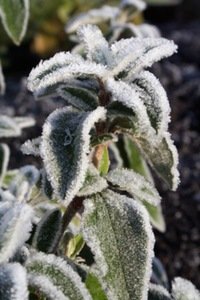





When It's Hot, It's . . .
If you've ever wondered why, after a clear, sunny and mild day, you have to prepare your plants for the possibility of a frost or freeze, then this article is for you. For example, why is it that on some Spring days, the sun warms everything up and the following night, all stays warm, while on other Spring days the sun warms everything up and the following night is cold?
The difference between the two days has to do with the water vapor in the air, or what is known as relative humidity (RH). No, that is not a term to describe your uncle after an hour in the hot sun, it refers to the amount of water vapor that can be held in air at a given temperature. The higher the temperature, the more moisture can be held in the air. That means that on a day when the temperature is 80 degrees F and 75% RH, a lot more moisture is in the air than on a day at 50 degrees F and 90% RH. The "relative" part refers to a comparison with the total amount of moisture that can be held in the air at that given temperature.
For example, if you are told that the RH is 50%, that means that the air is holding 50% of the moisture that it is capable of holding at that temperature. The amount of moisture that air can hold is always relative to the air temperature; hence, relative humidity. Because of this fact, you cannot have just "humidity" because you have to know the temperature in order for the humidity measurement to make any sense.

We've all experienced how dry the air gets indoors when cold outside air is heated to 75 degrees F to make it comfy inside. This is because if the outdoor air is at 25 degrees F and 60% RH, and you warm it up to 75 degrees F without adding any moisture, the RH is going to drop precipitously. The amount of moisture required to make the colder air 60% RH is just a fraction of the moisture that the 75 degree F air can hold, so the RH of the heated air will drop quite a bit.
So what does that have to do with how warm or cold the night is after a clear, warm sunny day? It has to do with how quickly the heat from the sun escapes, or radiates, away after the daylight is over. On a dry day, the sun warms the ground and plants, but the air has little moisture to warm. At night, the longwave infrared radiation escapes from the plants and ground and fewer moisture molecules are in the air to stop it from radiating right out into space. This process is known as radiational cooling.
By contrast, a clear warm day with high RH means that a lot of water molecules are floating around in the air. These molecules absorb the longwave radiation, then later emit it again. A good percentage of that re-emitted radiation hits other molecules, trees, plants or the ground, keeping them warmer. This process continues all night so a lot less of the radiation is lost to space. That's why the night stays warmer. You may even notice fog forming if the temperature drops low enough for the water molecules to begin condensing. The temperature at which that happens is called the dew point, and that temperature varies as the RH varies.
Knowing this also explains why a hot desert day can be followed by a freezing night, even in a southern desert, and why cloudy nights stay warmer than clear ones do. Relative humidity also plays a major role in other weather phenomena, such as rain and snowfall, and severe storms like hurricanes.
Next: When Water Falls: Fronts and Air Pressure
Photo credit: Copyright Free Photos
(Editor's Note: This article was originally published on May 7, 2008. Your comments are welcome, but please be aware that authors of previously published articles may not be able to promptly respond to new questions or comments.)Air Circulation for Nepenthes and Humidity for Butterworts
Garden Watering Hampshire Tips and Hints for Gardeners
Best 5 Gardening Tools for New Gardeners and Homeowners
Cold Weather St Augustine and Brevard Lawn Care
Layering and Air Layering Methods for Plant Propagation
suggestions for plants to hide air conditioners and pool equipment
grass alternative for dry and partly shaded area
A New Boon For Gardeners :compost Tea.
Permaculture Principles for Practical Gardeners and also Farmers
A Greenhouse Kit For Both Amateur And Professional Gardeners
Botany for Gardeners - Mitosis and Meiosis in Plants
8 Surefire Vegetables and Herbs for Beginning Urban Gardeners
Copyright © www.100flowers.win Botanic Garden All Rights Reserved